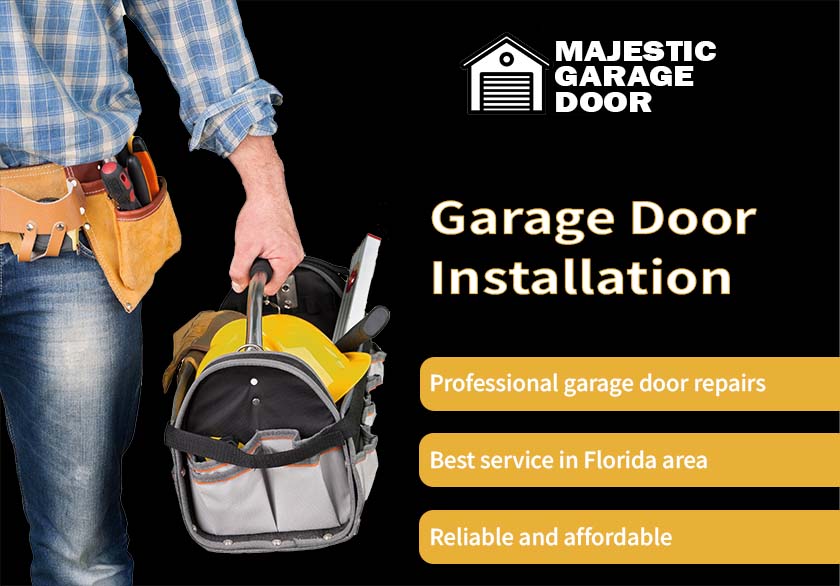Garage doors play a crucial role in providing security, convenience, and curb appeal to residential and commercial properties. Whether you’re considering replacing an old garage door or installing a brand-new one, understanding the intricacies of the process is essential.
In this article, we will delve into the world of garage door repairs and installation, focusing on the vibrant city of Vero Beach, FL.
We will explore the benefits of using garage door services and hiring professionals versus taking the DIY route, delve into the factors that influence the cost of installation, and provide insights into the necessary materials and considerations for a successful garage door install project.
Whether you’re a homeowner or a business owner in Vero Beach, this comprehensive guide will equip you with the knowledge needed to make informed decisions regarding garage door install and repair.

Garage Door Repair and Installation in Vero beach FL
Garage doors are an essential part of any residential house or commercial property, providing security, convenience, and aesthetic appeal.
Whether you are looking to replace an old garage door or install a brand-new one, it’s crucial to understand the process and the factors that influence the cost.
In this article, we will explore the topic of garage door installation, focusing on the Vero Beach, FL area. We will also discuss the pros and cons of DIY garage door install versus hiring a professional, the cost involved, and the factors that influence the overall installation expenses.
Can You Install Your Own Garage Doors?
Installing your own garage door is possible, but it is a complex and potentially dangerous task that requires specific knowledge, skills, and tools. It is important to consider several factors before deciding whether to install your own garage door:
- Expertise and Experience: Garage door installation involves intricate steps such as measuring, aligning, and balancing the door, installing tracks and rollers, connecting springs and cables, and configuring the opener system.
If you lack experience in handling these tasks, it is advisable to hire a professional who has the necessary expertise. - Safety Risks: Garage doors are heavy and can cause serious injuries if mishandled. Improper installation may lead to the door falling unexpectedly or malfunctioning, posing risks to you, your family, and your property.
Professional installers have the knowledge and experience to ensure the installation is carried out safely. - Tools and Equipment: Installing a garage door requires specialized tools and equipment that may not be readily available to homeowners. Professionals have access to the necessary tools and can perform the installation efficiently and effectively.
- Warranty and Insurance: When you hire a professional to install your garage door, they often provide warranties on both the installation and the product.
This ensures that any potential issues or defects can be addressed without additional cost. Additionally, professional installers carry insurance that protects you and your property in case of accidents or damage during the installation process.
While it may be tempting to save money by installing your own garage door, the risks involved and the potential for costly mistakes make hiring a professional the safer and more reliable choice.
A professional installer can ensure proper installation, optimize performance, and provide you with peace of mind knowing that the job is done correctly.
DIY Garage Door Installation vs. Hiring a Professional
When it comes to installing a garage door, homeowners often debate whether to tackle the project themselves or hire a professional. While a DIY installation may seem like a cost-effective and efficient option, it is essential to consider the complexity and potential risks involved.
Garage door install requires specific tools, knowledge, and expertise, and any mistakes can lead to safety hazards and additional expenses down the line.
Hiring a professional garage door repair company for your garage door installation in Vero Beach, FL, offers several advantages. Firstly, professionals have the necessary skills and experience to handle the installation process efficiently and safely.
They can ensure that the door is correctly aligned, the springs are properly balanced, and all components are functioning correctly.
Secondly, professionals have access to specialized tools and equipment, which are essential for a successful installation or repair. They can handle heavy garage doors, safely install tracks and rollers, and adjust the door opener for optimal performance.
Additionally, hiring a professional can save you time and effort, allowing you to focus on other tasks while the installation or any necessary repairs is being carried out.
How Much Does Garage Door Install Cost?
The exact cost of garage door installation in Vero Beach, FL, can vary depending on several factors. On average, homeowners can expect to pay between $800 and $1,500 for a standard garage door install service. However, the overall cost can increase or decrease based on specific variables.
Here are some estimates on the costs of garage door installation:
| Factors | Estimated Cost Range |
|---|---|
| Basic Single Garage Door | $800 – $1,200 |
| Basic Double Garage Door | $1,200 – $2,000 |
| Garage Door Opener Installation | $200 – $500 |
| High-End Garage Door | $1,500 – $4,000+ |
| Additional Features (Insulation, Windows, etc.) | $100 – $500 per feature |
| Professional Installation | $500 – $1,000 (may vary based on complexity) |
| DIY Installation | Cost of materials + personal time and effort |
These estimates are meant to provide a general idea of garage door installation costs. It’s important to obtain specific quotes from local professionals for accurate pricing based on your unique requirements and location.
Factors Influencing Garage Door Install Cost
- Required Materials: The materials you choose for your garage door can significantly impact the installation cost. Common options include steel, wood, aluminum, and fiberglass. Each material has its pros and cons in terms of durability, maintenance, and aesthetics. Steel doors, for example, are typically more affordable than wooden ones.
- Garage Door Size: The size of your garage door will influence the overall cost. Larger doors require more materials, and their installation may require additional labor. It’s important to accurately measure the width and height of your garage opening to determine the appropriate door size.
- Number of Garage Doors: If you have multiple garage doors, the cost of installation will naturally increase. Each door requires individual attention and materials, contributing to the overall expenses.
- Type of Garage Door Opener: The type of garage door opener you choose will also affect the installation cost. Chain-drive openers are typically more affordable, while belt-drive or screw-drive openers may come at a higher price point.
- Additional Features: Optional features such as insulation, windows, and decorative hardware can add to the overall cost. While these features enhance the functionality and appearance of the garage door, they may increase the installation expenses.
Required Materials for this Garage Door Installation Project
To install a garage door and system, you will need the following materials:
- Garage Door: Choose a door that suits your needs and preferences, considering factors such as material, insulation, and design.
- Tracks and Rollers: These components allow the door to open and close smoothly. Ensure they are made of durable materials and properly aligned.
- Springs: Garage door springs provide the necessary counterbalance to make the door easy to open and close. It’s crucial to choose the right type and size of springs for your specific door.
- Opener: Select a garage door opener that matches the weight and size of your door. Consider factors such as noise level, security features, and remote access options.
- Hardware and Fasteners: You will need various screws, bolts, hinges, and brackets to secure the door and its components in place.
Garage Door Size
Garage door size is an important consideration when it comes to installation. The size of your garage opening will determine the dimensions of the door you need.
Standard garage door sizes typically range from 8 to 18 feet wide and 7 to 8 feet tall for single-car garages, while double-car garages may require doors ranging from 12 to 24 feet wide and 7 to 8 feet tall.
It is crucial to measure your garage opening accurately to ensure a proper fit. Choosing the right size door is essential not only for functionality but also for aesthetic appeal, as a door that is too small or garage door openers too large can negatively impact the overall appearance of your property.
Consulting with a professional can help you determine the appropriate size for your garage door installation.
Garage Door Opener
Garage door openers are an integral part of any modern garage door system, providing convenience and ease of operation. These motorized devices allow you to open and close your garage door with just a push of a button.
When considering a garage door installation, selecting the right type of opener is crucial. There are various types of garage door openers available, including chain-drive, belt-drive, screw-drive, and direct-drive openers.
Each type has its own advantages and considerations in terms of noise level, maintenance requirements, and price. Chain-drive openers are known for their affordability, while belt-drive openers offer quieter operation.
Screw-drive openers are durable and require less maintenance, while direct-drive openers provide smooth and reliable performance. Choosing the appropriate garage door opener that suits your needs and budget is an essential aspect of a successful garage door installation project.
Number of Garage Doors
The number of garage doors you have is another factor to consider during the installation process. Some properties have a single large garage door, while others may have a single panel garage door or multiple smaller doors.
Each garage door requires individual attention and materials, which can influence the overall install cost. Additionally, having multiple garage doors may affect the aesthetic appeal and functionality of your property.
Whether you have one or more garage doors, it is important to ensure that they are properly installed, fixed, balanced, and aligned to guarantee smooth operation and enhance the overall security and convenience of your garage space.
Consulting with a professional can help you determine the best approach for installing and maintaining multiple garage doors to meet your specific needs.
How To DIY Install a Garage Door
While a DIY garage door installation is a complex project, here are some quick steps to give you an overview of the process.
Keep in mind that these steps are simplified, and it is highly recommended to consult manufacturer instructions and guidelines for your specific garage door model before attempting the installation:
- Gather the necessary tools and materials: This may include a tape measure, level, drill, wrenches, screws, and the garage door components.
- Measure and prepare the opening: Measure the width and height of the garage opening to determine the appropriate door size. Clear the area and ensure there is adequate space for the door tracks and opener.
- Install the door tracks: Attach the vertical tracks to the sides of the opening, followed by the horizontal tracks near the ceiling. Ensure they are level and securely fastened.
- Attach the door panels: Starting from the bottom, secure the door panels to the tracks using hinges. Follow the manufacturer’s instructions for the specific panel attachment method.
- Install the rollers: Attach the rollers to the sides of each door panel, ensuring they are properly aligned with the tracks. Rollers allow the door to move smoothly along the tracks.
- Install the torsion springs or extension springs: Depending on your garage door type, follow the instructions to install the appropriate springs. This step requires caution and should be approached with care due to the potential risks involved.
- Install the lifting cables: Attach the lifting cables to the bottom brackets of the door panels and run them through the pulleys. Connect the cables to the springs according to the manufacturer’s instructions.
- Install the bottom seal and weather-stripping: Attach the bottom seal to the bottom of the door to provide a weather-tight seal. Install weather-stripping around the sides and top of the door for added insulation.
- Install the door opener (optional): If you choose to install a garage door opener, follow the manufacturer’s instructions carefully. This involves mounting the opener unit, connecting the drive mechanism to the door, and wiring the opener to a power source.
- Test the door: Check the door’s operation by manually opening and closing it several times to ensure smooth movement. If using a garage door opener, test the remote control and safety features.
It is important for customers to note that garage door installation can be challenging, and if you are unsure about any step or lack experience, it is recommended to hire a professional installer for a safe and efficient installation.
Garage Door Opener Installation
Installing a garage door opener yourself is possible if you have some experience with DIY projects and a good understanding of electrical systems.
However, it’s important to note that it can still be a complex task, and if you are unsure or uncomfortable, it is highly recommended to hire a professional for the installation job. Here’s a simplified guide for DIY garage door opener installation:
- Gather Tools and Materials: Collect all the necessary tools and materials required for the installation, including a tape measure, level, drill, wrenches, screws, and the garage door opener kit.
- Prep Work: Before starting the installation, ensure the garage door is in good working condition and properly balanced. If necessary, perform any maintenance or repairs before proceeding.
- Install the Opener Unit: Follow the manufacturer’s instructions to mount the opener unit to the ceiling or wall of the garage. Make sure it is securely attached and aligned properly.
- Install the Rail and Trolley: Attach the rail to the opener unit according to the manufacturer’s instructions. Then, connect the trolley to the rail, ensuring it slides smoothly along the rail.
- Install Safety Sensors: Mount the safety sensors on each side of the garage door, a few inches above the ground. Align them properly and connect the wiring according to the manufacturer’s instructions.
- Connect the Arm and Attach the Bracket: Connect the arm to the trolley and attach the bracket to the top section of the garage door. Ensure they are securely fastened and aligned.
- Install the Control Panel and Keypad (Optional): If your garage door opener includes a control panel or keypad, follow the manufacturer’s instructions to install and wire them properly.
- Connect the Wiring: Carefully connect the wiring from the opener unit to the control panel, safety sensors, and power source. Take necessary precautions and ensure all connections are secure.
- Test and Adjust: Test the garage door opener by operating it using the control panel or remote. Make sure the door opens and closes smoothly and that the safety sensors are functioning correctly. Adjust the opener settings as needed.
- Program Remote Controls (If Applicable): If your garage door opener comes with remote controls, follow the manufacturer’s instructions to program them according to your preferences.
Remember, this is a simplified guide, and it’s essential to follow the manufacturer’s instructions specific to your garage door opener model.
If you encounter any difficulties, feel unsure, or lack experience, it is recommended to seek the assistance of a professional garage door installer to ensure a safe and proper installation.
Conclusion
Garage door installation is a significant investment that requires careful consideration. While DIY installation may seem tempting, hiring a professional offers customers several advantages, including expertise, safety, and efficiency.
The cost of garage door installation in Vero Beach, FL, can vary based on factors such as materials, size, number of doors, and type of opener.
It’s important to choose the right materials and ensure proper installation to maximize the longevity and functionality of your garage door. By understanding these aspects, you can make an informed decision and enjoy a smooth and hassle-free garage door installation experience.
Garage Door Installation FAQ
Can you do your own garage door installation?
If your garage door is not properly installed and maintained, it’s not an issue if you don’t do it. Installing the door yourself can be quite beneficial.
While it is possible to do your own garage door installation, it is a complex task that requires specific knowledge, skills, and tools. It is recommended to hire a professional for a safe and efficient installation.
Professional installers have the expertise to handle the intricacies of the process, ensuring proper alignment, balancing, and functioning of the door.
Are garage door openers easy to install?
Installation and replacement of garage door openers is a moderately tricky task, which can be done in just an afternoon with tools you may already have in your house.
The ease of installing a garage door opener can vary depending on your level of experience and the specific type of opener. While some homeowners with a good understanding of DIY projects may find it manageable, others may struggle with the complexities involved.
It is generally recommended to have a professional install the opener to ensure correct installation, proper wiring, and optimal performance.
Can I install my own garage door opener?
Is Garage Opener possible? Most popular-brand garage doors come with detailed steps on how to connect the motor of and operate the opener and its components and to install the controls and electrical wiring.
Installing a garage door opener can be challenging and requires electrical knowledge and expertise. It involves working with wiring and configuring the opener system.
It is advisable to hire a professional for the installation to ensure proper functioning, safety, and adherence to electrical codes.
Can you add a door to a garage?
Yes, it is possible to add a door to an existing garage. This process typically involves creating an opening in the garage wall, framing the new door, installing the door itself, and ensuring proper weather sealing.
It is recommended to consult with a professional to determine the feasibility and appropriate steps for adding a door to your specific garage structure.
What is the toughest part of a garage door installation?
The toughest part of garage door installation can vary depending on individual circumstances and experience. However, some common challenges include accurately measuring and aligning the door and tracks, correctly balancing the springs, and ensuring proper installation of the opener system.
These tasks require precision and knowledge of the door mechanisms, making them potentially challenging for inexperienced individuals. Engaging the services of a professional installer can help overcome these challenges and ensure a successful installation.



